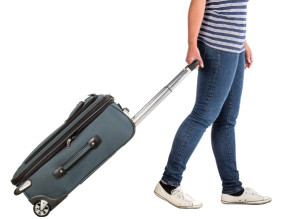
JetBlue is a low-cost carrier. Photo by Tony Hisgett on flickr
Today we’re featuring the second in a series of How to Travel on the Cheap by Jesse Miller, who writes for the website JenReviews.com.
This post is filled with tips on how to save money on different forms of transportation: flying, taking trains and buses, going on cruises, and utilizing public transportation, car services, and my own favorite method of getting around manageable distances: walking.
Here, then, are Jesse’s tips on getting the best deals on what is often the most expensive part of your vacation:
By Jesse Miller
In order to take your trip, you’ll need ways to get around. Because these transportation services are typically the most costly, it’s important to weigh your options based on your budget instead of convenience.
Even though flying is the most common mode of travel when taking a vacation, there are several alternatives to keep your expenses go a minimum. Whatever method you choose, though, the following tips will help you find the best deals possible.
FLIGHTS
1. Book your flight on a weekday.
The tickets that you will find for purchase during the week are on average less expensive than those offered on weekends. Specifically, Tuesdays around 3 p.m. are said to be the best times to find cheap flights. This is due to competitive price adjusting that occurs as a result of airlines announcing sales every Monday, so be sure to search through these deals towards the beginning of the week.
2. Stay ahead of the game.
While we covered the best day of the week to book flights above, the time until your departure can also affect how much you pay for a ticket. Purchasing your tickets a couple of months in advance — 54 days prior to departure, to be exact— may give you the cheapest options, while waiting until a week before will usually be much harder on your wallet.
3. Register baggage and carry-on items before showing up to the airport.
By adding your baggage to your ticket when booking a flight, you’ll be able to save some money and figure out how much you can pack for the trip. While it will still be possible to add these bags at the check-in counter, it will likely be more expensive to do so (especially on certain budget airlines, such as Spirit).
4. Travel Lighter.
If possible, try to fit your luggage into one carry-on lightweight luggage. While this means fewer changes of clothes that you can pack, it completely eliminates both the costs of checking baggage as well as the possibility that your bags will be lost by the airline. This is easier for shorter trips or if you’re staying somewhere that provides a washer or dryer, of course.

How I’d like to pack. Photo from ConsumerReports.org
Pro-Tip: A good travel backpack provides ample room for only the essential items. As a unique feature to the design, Venture Pal Lightweight Durable Travel Backpack is able to take the form of a backpack, duffel bag, and a messenger bag, allowing you to travel in whichever way you’d like. This bag is perfect for a week-long get-away to a warm location, but may be a little tougher to fit bulkier winter clothing into. Even if packing all your items isn’t possible in just this one bag, it still serves as a great, and stylish, addition to your carry-on baggage collection.
5. Explore foreign or lesser-known air services.
While it may be a little concerning to travel on a foreign airline, they are typically cheaper and just as safe as the normal flight companies that you’re used to. If ticket prices are comparable between domestic and foreign services, examine what amenities will be provided on the two different flights.
6. B.Y.O.S. (Bring Your Own Snacks)
Because prices at the airport are more expensive in general, packing snacks into your carry-on is a great way to keep your body fueled while pushing through a travel day. These pre-packaged snack shouldn’t be an issue when going through security screenings as long as you make sure not to bring any liquids. (You’ll still be stuck buying overpriced bottles of water after passing through security at the airport.)
7. Pack travel sized toiletries into your carry-on.
In general, it’s a good idea to have a toiletry kit for overnight trips amongst your travel gear. Travel-sized toiletries packages are great tools for those looking to get through security without having to toss out their toothpaste, shampoo, or conditioner.
8. Try Skyscanner.
For the truly savvy traveler, Skyscanner is an invaluable tool for acquiring incredibly cheap plane tickets. Like most other booking sites, Skyscanner offers the best deals it can find from a wide variety of both well-known and smaller airlines.
Something that makes it a little more special, however, is its continuous scanning of flights and email updates. If you are planning well in advance, you can set a price alert for your specific trip that will continuously update you on the best prices as you move closer and closer to your departure. This makes it easier to find the best time to buy cheap tickets.
OTHER TYPES OF TRANSPORTATION
9. If possible, avoid renting a car when you’re on vacation.
Explore the public transportation options provided by your destination before committing to rental car fees during your stay. By opting for the bus or train, you can quickly and easily move between the most popular locations without dealing with the hassle of traffic or navigating unfamiliar roads, and you may well save money.
10. Can you get a Lyft?
It’s also a good idea to look into taxi and rideshare services (like Uber and Lyft) before you travel to see if it’s possible to get around once public transportation stops running for the night. Unlike public transportation, these services are direct trips to where you need to go and can also save you a little time in getting back to where you’re staying.
Pro-Tip: Limit these services to the times that you absolutely have to use them. While more convenient than the bus or subway, they are also more expensive. When traveling abroad, research if these services are available in the country you’re traveling to. While they are very popular in America, rideshare services are slowly spreading to other parts of the world.
11. Walk everywhere you can.
Walking is good exercise and also good for the wallet, a win-win. If you choose to walk instead of paying for buses, trams, or subways, it’s best to plan your experiences for the day based on a general area. This allows you to see as much as possible in one spot while eliminating the fees for public transportation.

Walking is always a good option. Photo by Catharine Norton
By walking, you also get a fuller understanding of what your surroundings have to offer. This helps you feel the overall vibe of the city without having to pay anything for it. Just be sure to wear comfortable, sturdy walking shoes.
12. Take a bus or a train when traveling between landlocked countries.
Buses and trains eliminate the possibility of jet lag and offer you a view of the countryside. All in all, these methods of transportation are perfect for the frugal traveler because they’re cheaper and provide a better understanding of the places you’re traveling through. As a general rule of thumb, taking a bus is the cheapest (but most time-consuming) option available. Trains can often, though not always, be cheaper than flying, though train stations are typically more centrally located than airports, thus saving on taxi or shuttle fares to and from them.
13. Research the rail sites with the no/low middleman fees.
For example, Rail Europe is known to charge slightly higher than official prices with embedded booking fees, while booking direct with SNCF if you are in France or Trenitalia if you are in Italy will allow you to pay only the direct train ticket charges with no additional fees.
14. Explore bulk transportation options.
Before traveling, look into the most common modes of transportation (bus, rail, etc.) and see if there are any multiple-day passes that you can purchase to best preserve money. As you do this, think about how often you will realistically be using these sources to move around. If you will only need a couple of rides throughout your trip, it might be a better idea to simply buy a single-use ticket each time you need it.
15. Consider taking a cruise.
Cruises offer transportation, accommodation, food, and often entertainment and sightseeing all in one convenient package. Yes, you can add considerably to your bill by purchasing pricey shore excursions, drinks, and other extras, but these are optional, and many cruises especially river cruises) include at least some free tours in their base price. Book cruises well in advance to take advantage of two-for-one offers and other deals, but if you have flexibility in your schedule, you can take advantage of last-minute sales as well.
Up Next: Saving Money on Accommodations
Dear Readers: My new guidebook, 100 Things to Do in Tucson Before You Die (Reedy Press, 2017) is now available for purchase. For those outside the Tucson area, where it’s available at Barnes & Noble, Antigone Books and other bookstores, you can go to the book’s sale page at amazon.com and order it. Don’t forget to write a review!
Or, if you’d rather support clarknorton.com than Jeff Bezos, you can order directly from me at paypal.me/clarknorton; price of $19.35 includes sales tax and shipping. Be sure to send me an email at clark@clarknorton.com with your name and shipping address. We also accept major credit cards. Thanks!












3 Responses to How to Travel Cheaply: 15 Tips on Transport